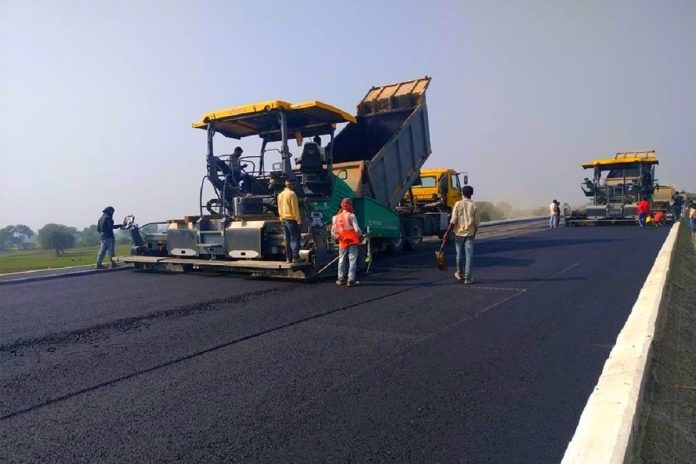Snapshot
In FY23, CRISIL forecasts that NHAI will sustain its FY 22 momentum and award 4,000-4,500 km of road projects. With a strong pipeline of projects under Bharatmala, Modi Government’s flagship scheme for building greenfield expressways and the ambitious ₹100 lakh crore National Infrastructure Pipeline, the NHAI will be able to continue the rapid pace of road construction.
The likely pace of awards, coupled with the government’s sharp focus on clearing land acquisition issues and ensuring swift payments, bode well for NHAI’s execution target of 4,300-4,600 km of roads this financial year and another 4,500-5,000 km in the next.
The vigour in awarding of road projects by the National Highways Authority of India (NHAI) seen this fiscal (FY22) will continue next fiscal (FY23) as well, with the hybrid annuity model (HAM) accounting for around half of it, according to a report by CRISIL.
The likely pace of awards, coupled with the government’s sharp focus on clearing land acquisition issues and ensuring swift payments, bode well for NHAI’s execution target of 4,300-4,600 km of roads this financial year and another 4,500-5,000 km in the next.
In FY23, CRISIL forecasts that NHAI will sustain its FY 22 momentum and award 4,000-4,500 km. With a strong pipeline of projects under Bharatmala, Modi Government’s flagship scheme for building greenfield expressways and the ambitious ₹100 lakh crore National Infrastructure Pipeline, the NHAI will be able to continue the pace of road construction.
Also in the recently unveiled National Monetisation Pipeline (NMP), the union government has set a target to garner ₹1,52,496 crore by monetising roads assets over the NMP period FY2022-5.
According to CRISIL, the National Monetisation Pipeline (NMP) alone could address 15-18 per cent of NHAI’s funding requirement for this financial year and the next, and help maintain the rapid pace of infrastructure development.
The aggregate length of assets considered for monetisation under NMP in the road sector over FY 2022 to 2025 is estimated to be 26,700 km.
The total length of highway assets considered for monetisation (26,700 km) constitutes nearly 22 per cent of the entire National Highways (estimated to be about 1,21,155 km), excluding the network operated by the private sector under BOT (Toll) based PPP concessions.
Of these, the government aims to monetise around 5,000 km of highways in FY22 to raise almost Rs 30,000 crore. In FY23, the plan is to raise Rs 32,855 crore by monetising 5,476 km of highways.
In FY24, the government’s goal is to monetise 7,330 km of highways to raise Rs 43,979 crore. Among the four years of NMP, FY25 constitutes the highest in the road sector with a plan to raise Rs 53,366 crore with the monetisation of 8,894 km of highways.
As an asset class, the roads and highways have already monetised operating road assets and have generated growth capital to construct new roads under programs like the Bharatmala program.
Since 2017, the NHAI has successfully monetised its brownfield road assets through Toll Operate Transfer (TOT)-based PPP concessions. The TOT model has since matured and is now an established model with a model concession framework already in place.
Another method of monetisation that has seen traction in the recent past is the InvIT model. Several road assets have been monetised through InvITs by private sector players.
NHAI’s HAM helps mid-sized regional player
A slew of mid-sized regional players grabbed a mighty 58% of the HAM awards during the first half of this fiscal — higher than 33% in fiscal 2021.
Between fiscal 2016, when the route was introduced, and fiscal 2020, their share was much lower at only 15%.
Interest in HAM has surged after the NHAI reduced the bid-eligibility criteria for its projects and made changes in the model concession agreement (MCA) to encourage private participation.
Of the total 4,500-5,000 km expected to be awarded in FY 22, 45-55% should be under the HAM mode, another 40-45% under the EPC mode, and <5% under the build operate-transfer (BOT)-toll mode. HAM had accounted for 54% of the awards last fiscal as well.
The reduction in bid-eligibility criteria has paved the path for mid-sized players to enter the space. On the flipside, the change has intensified competition, which is visible in the increase in the number of bidders to 10-15 from only 5-10 earlier and a decline in premium to 10-15% now from 15-20% previously, implying aggressive bidding.
Given the high order books and speedy construction, revenue of large road EPC companies is expected to rebound 15 per cent in FY22 after growing a modest 5 per cent last year.


